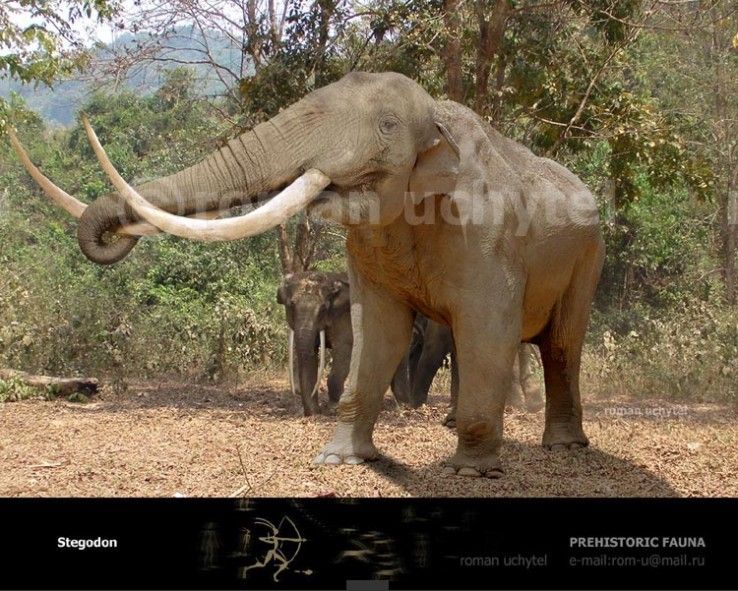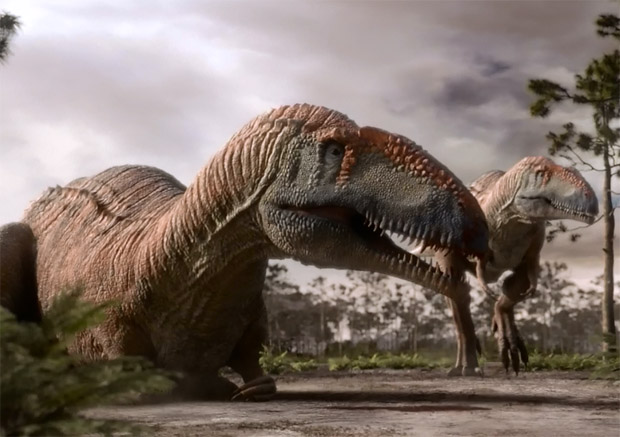Post by dinosauria101 on Mar 21, 2019 10:59:21 GMT 5
Stegodon zdanskyi
Stegodon (meaning "roofed tooth" from the Greek words στέγειν stegein 'to cover' and ὀδούς odous 'tooth', because of the distinctive ridges on the animal's molars) is a genus of the extinct subfamily Stegodontinae of the order Proboscidea. Stegodonts were present from 11.6 mya to the late Pleistocene, with unconfirmed records of localized survival until 4,100 years ago. Fossils are found in Asian and African strata dating from the late Miocene; during the Pleistocene, they lived across large parts of Asia, East and Central Africa. Stegodon was one of the largest proboscideans, along with more derived genera. S. zdanskyi is known from an old male (50+) from the Yellow River that is 3.87 metres (12.7 ft) tall and would have weighed approximately 12.7 tonnes (12.5 long tons; 14.0 short tons) in life. It had a humerus 1.21 metres (4.0 ft) long, a femur 1.46 metres (4.8 ft) long, and a pelvis 2 metres (6.6 ft) wide.

i53.photobucket.com/albums/g62/TigerQuoll/Extinct/Stegodon-738x591_zpsudb1bwbt.jpg
Mapusaurus roseae (pack of 2)
Mapusaurus ("Earth lizard") was a giant carnosaurian, Carcharodontosaurid dinosaur from the early Late Cretaceous (late Cenomanian to early Turonian stage) of what is now Argentina and possibly Chile. It was roughly similar in size to its close relative Giganotosaurus, averaging about 12.4 meters and 7 tons and getting to 13.6 meters long and 8.5 tons at maximum. The longest individual for which Coria and Currie (2006) provided a concrete estimate in Table 1 (apendix lll) is the animal to which femur MCF-PVPH-208.203 belonged; this individual is estimated as 10.2 metres (33 ft) long, but it is a juvenile. The fossil remains of Mapusaurus were discovered in a bone bed containing at least seven individuals of various growth stages. Coria and Currie speculated that this may represent a long term, possibly coincidental accumulation of carcasses (some sort of predator trap) and may provide clues about Mapusaurus behavior. Other known theropod bone beds include the Allosaurus-dominated Cleveland-Lloyd Dinosaur Quarry of Utah, an Albertosaurus bone bed from Alberta and a Daspletosaurus bone bed from Montana. Paleontologist Rodolfo Coria, of the Museo Carmen Funes, contrary to his published article, repeated in a press-conference earlier suggestions that this congregation of fossil bones may indicate that Mapusaurus hunted in groups and worked together to take down large prey, such as the immense sauropod Argentinosaurus. If so, this would be the first substantive evidence of gregarious behavior by large theropods other than Tyrannosaurus, although whether they might have hunted in organized packs (as wolves do) or simply attacked in a mob, is unknown.

Credit to Wikipedia
Stegodon (meaning "roofed tooth" from the Greek words στέγειν stegein 'to cover' and ὀδούς odous 'tooth', because of the distinctive ridges on the animal's molars) is a genus of the extinct subfamily Stegodontinae of the order Proboscidea. Stegodonts were present from 11.6 mya to the late Pleistocene, with unconfirmed records of localized survival until 4,100 years ago. Fossils are found in Asian and African strata dating from the late Miocene; during the Pleistocene, they lived across large parts of Asia, East and Central Africa. Stegodon was one of the largest proboscideans, along with more derived genera. S. zdanskyi is known from an old male (50+) from the Yellow River that is 3.87 metres (12.7 ft) tall and would have weighed approximately 12.7 tonnes (12.5 long tons; 14.0 short tons) in life. It had a humerus 1.21 metres (4.0 ft) long, a femur 1.46 metres (4.8 ft) long, and a pelvis 2 metres (6.6 ft) wide.

i53.photobucket.com/albums/g62/TigerQuoll/Extinct/Stegodon-738x591_zpsudb1bwbt.jpg
Mapusaurus roseae (pack of 2)
Mapusaurus ("Earth lizard") was a giant carnosaurian, Carcharodontosaurid dinosaur from the early Late Cretaceous (late Cenomanian to early Turonian stage) of what is now Argentina and possibly Chile. It was roughly similar in size to its close relative Giganotosaurus, averaging about 12.4 meters and 7 tons and getting to 13.6 meters long and 8.5 tons at maximum. The longest individual for which Coria and Currie (2006) provided a concrete estimate in Table 1 (apendix lll) is the animal to which femur MCF-PVPH-208.203 belonged; this individual is estimated as 10.2 metres (33 ft) long, but it is a juvenile. The fossil remains of Mapusaurus were discovered in a bone bed containing at least seven individuals of various growth stages. Coria and Currie speculated that this may represent a long term, possibly coincidental accumulation of carcasses (some sort of predator trap) and may provide clues about Mapusaurus behavior. Other known theropod bone beds include the Allosaurus-dominated Cleveland-Lloyd Dinosaur Quarry of Utah, an Albertosaurus bone bed from Alberta and a Daspletosaurus bone bed from Montana. Paleontologist Rodolfo Coria, of the Museo Carmen Funes, contrary to his published article, repeated in a press-conference earlier suggestions that this congregation of fossil bones may indicate that Mapusaurus hunted in groups and worked together to take down large prey, such as the immense sauropod Argentinosaurus. If so, this would be the first substantive evidence of gregarious behavior by large theropods other than Tyrannosaurus, although whether they might have hunted in organized packs (as wolves do) or simply attacked in a mob, is unknown.

Credit to Wikipedia




